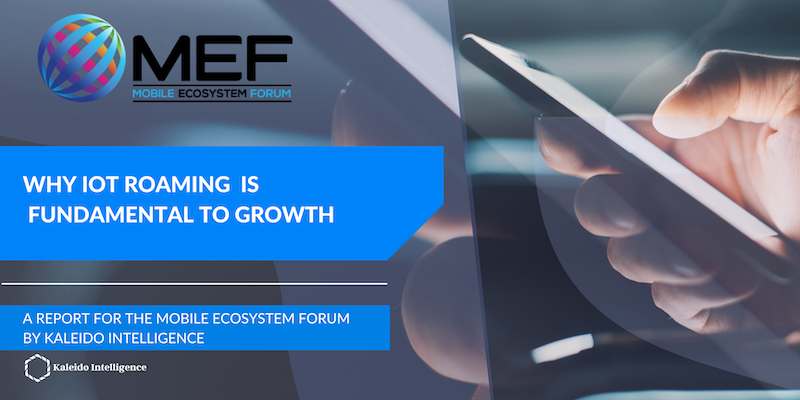MEF and Kaleido Intelligence have developed a report to examine why roaming is fundamental to IoT growth. Here, MEF IoT Programme Director Andrew Parkin White explains why roaming might hold the key to achieving IoT market growth.
The IoT market is too complex at present. For the market to develop more rapidly, the ecosystem needs to address a series of issues – achieving price points for non-specialised applications that become attractive to the enterprise, facilitating connectivity, device management and analytics and adding value to customers over and above current offerings as the market evolves from M2M to true IoT solutions.

In 2020, cellular connections accounted for around 14% of the total IoT connections. We expect to see more rapid growth here for reasons including
- falling hardware costs
- Innovation in the connectivity space to reduce supply chain complexity
- Deployment scaling and coverage
- The emergence of LPWAN (LTE-M and NB-IoT) standards
- COVID-19 facilitating remote working, automation and business process transformation efforts
Connected devices will eventually overtake the number of subscribers being served by CSPs. Maintaining quality and profitability for both will require roaming solutions that are powerful enough to recognise and categorise them. Flexibility is key to manage all devices with the highest precision to achieve the highest quality possible“
Brendan Cleary – CEO, Cellusys
A single country-focused deployment was a feature of earlier M2M deployments as they were of sufficiently high value to justify the time and expense for a local solution to be developed and subsequently rolled out in other countries. We are now at a very different stage of market development addressing a much broader target set of enterprises and this time-consuming and costly approach is no longer suitable. Furthermore, there was an absence of global solutions despite moves made by non-cellular technologies to provide low power, low cost solutions. The cellular industry could not afford to be left behind and developed the challenger technologies of LTE-M and NB-IoT.
Applications used by enterprises are becoming more global in nature and we are also seeing devices which be manufactured in one country with an installed SIM and subsequently deployed in another country. This in turn adds to a greater pressure for IoT roaming solutions. “Connected devices will eventually overtake the number of subscribers being served by CSPs. Maintaining quality and profitability for both will require roaming solutions that are powerful enough to recognise and categorise them. Flexibility is key to manage all devices with the highest precision to achieve the highest quality possible”, says Cellusys CEO Brendan Cleary – interviewed for the report.
Kaleido predicts that revenues from outbound and inbound IoT roaming traffic will exceed $36 billion in 2026, representing an average annual growth rate of 30% from 2020 as well as cumulative revenue of $119 billion over the next 5 years.
Presently, very few markets around the globe have taken a specific stance towards IoT roaming. This means that, in those markets, the baseline regulatory stance for roaming IoT devices remains the same as it is for consumer devices, where regulation and commercial agreements between operators have been developed under the assumption that connected devices will spend the majority of their lifetime within the operator’s home network.
One of the key reasons for banning permanent roaming is the fact that low device data volumes create signalling overhead costs that cannot be recouped through inbound data revenues. Nevertheless, at present, it is evident among operators that the impact of permanent roaming in this context has largely gone undetected. Nevertheless, operators have signalled a high level of concern over the impact of future permanent roaming,
In an ideal world, the eSIM can be used to secure seamless connectivity regardless of where the device is shipped to, meaning that OEMs can apply a ‘single SKU’ concept to design and production. Meanwhile,the eSIM offers fundamental benefits for enterprise customers in the sense that remote SIMs no longer have to be physically changed when a switch to a new connectivity provider is desired. The eSIM business case is predicated on devices crossing borders.
In the words of Rich Pellegrini, Sr. IoT Product Manager for iBASIS – “We are pleased to offer our customers global connectivity for their IoT devices with a single dynamically programmable eSIM. We utilize our global network and mobile expertise to deliver the IoT connectivity and media processing IoT service providers need from a single independent supplier.”
The full complimentary report is available from the MEF website and can be downloaded here.






